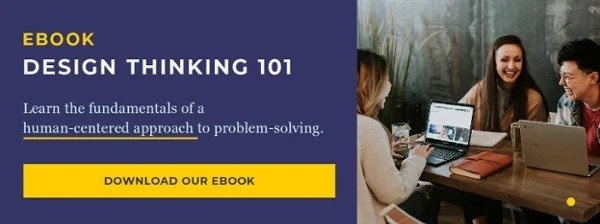Many DesignOps professionals are faced with the choice to work solely as an organization’s internal consultancy or play an additional role in scaling design capabilities. When design teams focus on the former, they struggle to get better projects and collaborators from within their organization. When design teams settle on the latter, they must navigate the complex terrain of scaling design capabilities.
In late September, ExperiencePoint’s Vice President of Transformation Andrew Webster conducted workshops on scaling design capabilities at the 2021 DesignOps Summit. Sponsored by Mural, the session covered how design teams can attract better internal projects, transfer essential capabilities and measure successful outcomes.
Read on for a recap of the event, Andrew’s direct recommendations and a link to the workshops on-demand.
Why Build Design Capability?
Not everyone is or can be a designer—why should they build their design capabilities? The return on the investment is enormous. Helping non-designers develop into novice or intermediate designers fosters a culture of innovation that is constantly ready to pivot and succeed.
As Jeanne Liedka states in her book Experiencing Design: The Innovator’s Journey, “being a design thinker doesn’t rely on whether you went to design school or not, or have innovation in your job title. The path is there for all of us if we are willing to make the journey”. When scaled correctly, design capabilities teach every worker to do these two things:
Be Better Clients
-
By helping peers embrace and apply simple design principles, their ability to contribute as partners on design projects is enhanced, making for faster projects with better outcomes.
Bring Better Projects
-
By helping peers understand design parameters, the work asked of design teams is more appropriately scoped for the most significant impact.
Why Define Success Metrics?
Many organizations set success metrics to discern when a goal is met. However, defining success metrics is also essential to ensure that project expectations are realistic and aligned with others.
To avoid misalignment at your organization, consider these three types of key performance indicators (KPIs) when defining your success metrics.
-
Programmatic KPIs: Leading Indicators of Success
-
These are KPIs that describe the inputs and progress of the project. For example, the number of workshops, participants and locations impacted.
-
Behavior KPIs: Early Indicators of Success
-
These are KPIs that describe measurable changes in behavior when using new skills. For example, the number of users observed or the number of prototypes built.
-
Outcome KPIs: Lagging Indicators of Success
-
These KPIs describe the outcomes of new behaviors. For example, increased revenue, customer retention rate and decreased time-to-market.
Scaling Behaviour Change: Where To Start
When scaling behavior change, start by selecting projects with the most significant social influence. For instance, projects that focus on dissatisfaction with current approaches and solutions will likely render substantial business impacts and emotionally resonate with employees. Projects that create motion within organizations generate buzz and excitement while also paying off in the long run.
Once you’ve selected where to start, execute the project according to the principle, ‘chunk, don’t sprinkle.’ Concentrate on less than 50% of the workplace population, targeting a substantial business unit. To foster a shared vision amongst all participants, remember to draw connections between design capabilities and the ultimate goal of being a more innovative and efficient organization. Lastly, put in place the right skills and conditions to ensure that change is sustained and ongoing.
Watch the Full Workshops
Day 1: Wednesday, September 29th, 2021
Day 2: Thursday, September 30th, 2021
MURAL for Design Teams
If you haven’t yet collaborated visually with your team using MURAL, join for free and see where it takes you. Design teams use MURAL’s digital workspace to solve customer problems and master design thinking, scaling processes and best practices across teams. Learn more about MURAL for design teams here.
